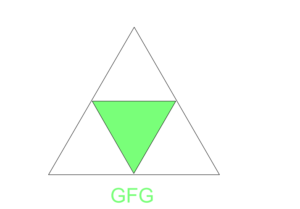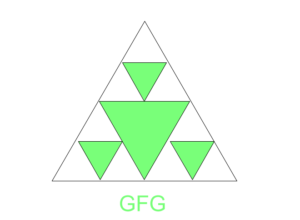Dado un triángulo equilátero, la tarea es calcular el número total de triángulos después de realizar la siguiente operación N veces.
Para cada operación, los triángulos sin color se toman y se dividen en 4 triángulos equiláteros iguales. Cada triángulo invertido formado está coloreado. Consulte la siguiente figura para obtener más detalles.
Para N=1 el triángulo formado es:

Para N=2 el triángulo formado es:

Ejemplos:
Entrada: N = 10
Salida: 118097
Entrada: N = 2
Salida: 17
Acercarse:
- En cada operación se forman 3 triángulos sin color, 1 triángulo de color y el propio triángulo
- Al escribir la declaración anterior matemáticamente; recuento de triángulos en el N-ésimo movimiento = 3 * recuento de triángulos en el (N-1)-ésimo movimiento + 2
- Por lo tanto, inicializando una variable curr = 1 y tri_count = 0
- A continuación, se itera un ciclo de 1 a N
- Para cada iteración, se realiza la operación mencionada anteriormente.
- Finalmente, se devuelve el tri_count
A continuación se muestra la implementación del enfoque anterior:
C++
#include <bits/stdc++.h>
using namespace std;
// function to return the
// total no.of Triangles
int CountTriangles(int n)
{
int curr = 1;
int Tri_count = 0;
for (int i = 1; i <= n; i++) {
// For every subtriangle formed
// there are possibilities of
// generating (curr*3)+2
Tri_count = (curr * 3) + 2;
// Changing the curr value to Tri_count
curr = Tri_count;
}
return Tri_count;
}
// driver code
int main()
{
int n = 10;
cout << CountTriangles(n);
return 0;
}
Java
class Gfg {
// Method to return the
// total no.of Triangles
public static int CountTriangles(int n)
{
int curr = 1;
int Tri_count = 0;
for (int i = 1; i <= n; i++) {
// For every subtriangle formed
// there are possibilities of
// generating (curr*3)+2
Tri_count = (curr * 3) + 2;
// Changing the curr value to Tri_count
curr = Tri_count;
}
return Tri_count;
}
// driver code
public static void main(String[] args)
{
int n = 10;
System.out.println(CountTriangles(n));
}
}
Python
# Function to return the # total no.of Triangles def countTriangles(n): curr = 1 Tri_count = 0 for i in range(1, n + 1): # For every subtriangle formed # there are possibilities of # generating (curr * 3)+2 Tri_count = (curr * 3) + 2 # Changing the curr value to Tri_count curr = Tri_count return Tri_count n = 10 print(countTriangles(n))
C#
using System;
class Gfg
{
// Method to return the
// total no.of Triangles
public static int CountTriangles(int n)
{
int curr = 1;
int Tri_count = 0;
for (int i = 1; i <= n; i++)
{
// For every subtriangle formed
// there are possibilities of
// generating (curr*3)+2
Tri_count = (curr * 3) + 2;
// Changing the curr value to Tri_count
curr = Tri_count;
}
return Tri_count;
}
// Driver code
public static void Main(String[] args)
{
int n = 10;
Console.WriteLine(CountTriangles(n));
}
}
// This code is contributed by 29AjayKumar
Javascript
<script>
// Method to return the
// total no.of Triangles
function CountTriangles(n)
{
var curr = 1;
var Tri_count = 0;
for (i = 1; i <= n; i++)
{
// For every subtriangle formed
// there are possibilities of
// generating (curr*3)+2
Tri_count = (curr * 3) + 2;
// Changing the curr value to Tri_count
curr = Tri_count;
}
return Tri_count;
}
// driver code
var n = 10;
document.write(CountTriangles(n));
// This code is contributed by aashish1995
</script>
118097
Complejidad de tiempo: O(n)
Espacio Auxiliar: O(1)
Publicación traducida automáticamente
Artículo escrito por imran_shaik y traducido por Barcelona Geeks. The original can be accessed here. Licence: CCBY-SA